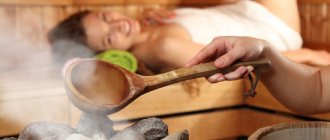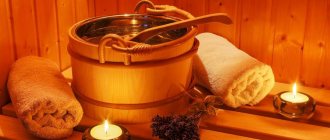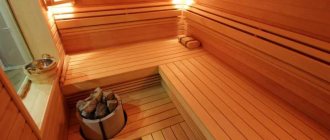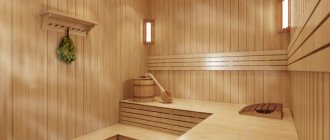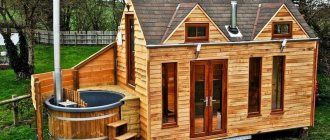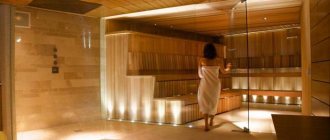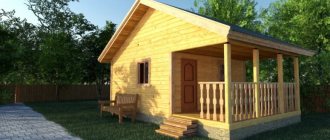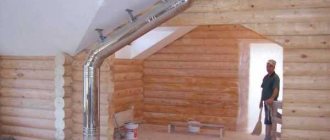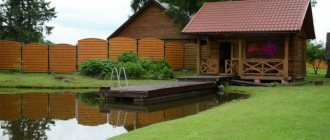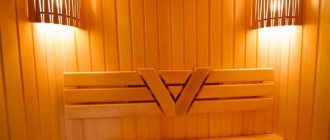The benefits and harms of a Finnish steam room
The benefits of performing procedures in a steam room using Finnish technology are obvious for all systems of the body - genitourinary, cardiovascular, nervous and respiratory.
The Finnish sauna accelerates blood flow, dilates blood vessels, and improves skin condition. The bath has a positive effect on the skin for the following diseases: psoriasis, eczema, acne and urticaria.
What makes a sauna especially beneficial for the human body is low humidity at high temperatures. Dry hot air cleanses the upper respiratory tract, improves the condition of the mucous membranes, and ventilates the lungs. In addition, a good warm-up of the body improves metabolic processes in the body, which contributes to slight weight loss.
The benefits of visiting a sauna are obvious for the human nervous system - hot air promotes maximum relaxation, relieving fatigue and anxiety.
High temperatures are detrimental to pathogens, so a Finnish steam room is the best place to prevent colds.
Considering all the positive aspects of the sauna, before visiting the procedures you should carefully read the available contraindications.
Visiting the steam room is prohibited:
- For chronic inflammatory diseases of internal organs;
- For oncology and in the postoperative period;
- Women during pregnancy and lactation;
- For acute diseases of the skin, respiratory tract, cardiovascular system;
- At high temperature;
- For hypertension, epilepsy, tuberculosis;
- People over 60 years of age;
- Children under 4 years old.
In order not to cause harm to health and in the presence of any diseases, it is recommended to consult a doctor before visiting a Finnish sauna.
The Finnish sauna is a wonderful way to cleanse and strengthen the body, capable of providing a maximum boost of energy and good mood for the whole day.
Contraindications
It is important not to forget about contraindications for visiting the sauna. You can't go there if:
- body temperature is higher than normal;
- infectious disease confirmed;
- a non-infectious disease has worsened;
- have cancer;
- Serious problems with the heart, blood vessels, skin and lungs were discovered.
Anyone over 60 years of age who suffers from chronic inflammation or high blood pressure can visit a Finnish bath only with the permission of a doctor. It is unacceptable for children under 4 years of age to steam in a sauna; older children require a full examination and the consent of a doctor. By following the recommendations for building a Finnish sauna, arranging its interior space and using a sauna, you can achieve good results in construction and improve your health.
See below for more details.
Construction
The traditional classic Russian version of the bathhouse is a separate building with a dressing room. There is a locker room in front of the entrance to the steam room. For the construction of the steam room, logs from pine, spruce, and deciduous trees are used.
The hallway serves as a place for mounting the stove unit, which mostly penetrates into the steam room. The operating principle of the device is aimed at generating the maximum amount of heat necessary to pump the required air temperature. Furnace equipment is usually built from brick, stainless steel, and cast iron. A pile of stones is placed inside. To preserve heat, the structure is covered with a door.
Finnish saunas come in a variety of shapes: tents, barrels. Steam rooms are placed in the forest, buried in the ground. There are also options made from ice. Such a variety of types is not found either in Russian or Turkish bath culture.
Important! For the construction of the Finnish steam room, wood that is resistant to high temperatures is used. Before erecting a building, the material is carefully processed to prevent rotting and the release of harmful resins
Cedar and aspen are more often used in construction.
The difference from a Russian bathhouse is the presence of a shower room and a spacious dressing room with furniture.
The external difference between the steam rooms of Russia and Finland is immediately noticeable. Russian baths are simple, without unnecessary frills. The Finns, on the contrary, try to give the steam room a luxurious, expressive look, complementing the interior with designer lamps, carved doors, and furnishing it with exquisite pieces of furniture.
Sauna design:
Initial stage of construction
When constructing a bathhouse yourself, you must adhere to a clear sequence. Compliance with technology serves as the basis for the proper functioning of such a complex as a Finnish sauna. A bathhouse built incorrectly will cause discomfort to its visitors from the very first minutes, and the healing effect will be reduced to zero.
Even the little things matter. The construction procedure is carried out according to a certain scheme.
Initially, the floor of the steam room is arranged. It is allowed to use wood for this. However, this is not the best material for a sauna floor. It cannot be varnished. And without treatment, the durability of wood in humid conditions is reduced.
The best flooring for a bathhouse is tile. It will be durable and practical, as well as meeting all sanitary and hygienic requirements.
After this, the frame is assembled.
The box is installed according to the diagram calculated in accordance with the dimensions of the bathhouse. To do this, use wooden combs, nylon dowels, and screws.
The ceiling frame is assembled by connecting timber.
A place is provided for installing doors.
Advantages and disadvantages of a Finnish sauna made of laminated timber
Today, baths are built from different materials, most often using timber. In this case, buildings made of timber can be divided into several varieties, in accordance with the type of material used - solid, profiled or glued.
Each type of timber has its own advantages and disadvantages, but laminated timber is currently in the widest demand.
Recommended reading:
- Service life of a wooden house
- Construction technology of a half-timbered house
- Types of foundations for a private house
Speaking about the advantages of a Finnish sauna made of laminated veneer lumber, we note that this material retains heat well and is also completely environmentally friendly, since the amount of glue it contains is much less compared to, for example, chipboard or OSB. This indicator of laminated lumber is slightly higher than that of other types of timber, but at the same time, due to the glue, the likelihood of its rotting and cracking of construction raw materials is reduced.
Laminated timber baths can vary in size and design, interior decoration and layout. However, any of these designs has the same advantages:
- Aesthetic appearance. A bathhouse made of laminated timber does not require mandatory external and internal finishing. For example, ordinary timber sometimes has various surface defects that negatively affect the overall appearance of the room, while the glued variety is characterized by uniformity and smoothness of the material. Looking at the photos of buildings made from this type of lumber, you will be convinced of the beauty and accuracy of execution.
- Simplicity of finishing work. If you nevertheless decide to start interior or exterior finishing, then such work can begin as soon as you finish construction, since the shrinkage of laminated veneer lumber is minimal - only 2%. For example, the shrinkage of a rounded log is about 20%, which can significantly affect the results of finishing work after completion.
- Free choice of foundation. Laying the foundation is a special expense item during construction. If a material such as laminated veneer lumber is used for these purposes, there is no need to use a massive foundation; such a task is quite possible with columnar, strip and pile types of foundations. This possibility is ensured by the lightness of the material, whose specific gravity is significantly lower in comparison with other building materials, for example, blocks and bricks (from 400 to 500 kilograms per cubic meter with a maximum humidity level of 12%).
- High quality. Glued laminated timber will not crack or dry out, and therefore you will not need to resort to puttying. Even during the production process of the material, the lamellas are carefully selected and sorted in accordance with quality, texture, color, due to which the appearance of laminated veneer lumber is impeccable.
- Possibility to choose the shape of the finished structure. A bathhouse of any configuration can be built from the material (with a balcony, terrace, attic, etc.), with a different number of rooms.
- Saving money. The correct technology used when assembling a Finnish bathhouse from laminated veneer lumber will allow you not to use additional insulation and, accordingly, eliminate material costs for it;
- The smell of natural wood. A sauna made of laminated timber will delight you with a cozy atmosphere and the smell of fresh wood. These additional benefits will make your bathing experience even more enjoyable.
- Good thermal insulation. Due to the characteristics of the material, there are no gaps in the finished structure, and the walls are many times warmer than when using brick; buildings do not require interventional insulation, which also reduces costs.
- Increased strength, since structures made of laminated veneer lumber are much stronger than structures made of solid wood (by about 60%);
- Resistant to external factors. Special impregnation gives the laminated timber not only resistance to moisture, but also fireproof qualities.
- Durability, the minimum service life of structures made of laminated veneer lumber is fifty years, which is exactly the time when this material began to be actively used in construction. As for the maximum service life, it is not known today.
What it is?
Historically, a Finnish sauna is a low, enclosed, small space from 2 to 6–8 square meters. m, designed for 2–3 people. Previously, such baths were heated by a hearth placed in the center of the room with hot stones. There was no chimney as such; ventilation was carried out through an open door and an inlet near the floor. The room was very dry and hot.
Instead of a washing room, there was a barrel with cold water or there was a natural pond nearby.
Modern technologies have made it possible to get rid of suffocating smoke and soot using ventilation systems and new modifications of stoves with chimneys. A barrel of water has been replaced by a font, pool or shower. The absence of windows is compensated for by electric lighting.
What must be included in the bathhouse project
Individual and standard projects for bathhouses made of timber should fully disclose the following points:
- the category of foundation that will be optimal for the selected type of steam room, features of its drainage system, techniques that provide protection from moisture. Experts offer a separate drawing of the base;
- methods of joining and making corner joints of timber. It is necessary to specify in the project the characteristics of the material from which the partitions and the frame itself will be assembled - cross-section, type of wood;
- roof design, materials used, insulation options, if necessary;
Bathhouse made of timber with an attic, terrace and balconySource banya-expert.com
- what will the floors be made of in the steam room, washing room and additional rooms;
- does the future building need additional insulation measures, what methods are acceptable;
- number of openings - doors and windows, their arrangement, specifics of glazing;
- a detailed description of communications - electricity supply systems, ventilation, placement of drainage elements.
The bath sketch includes basic positions:
- foundation plan;
- detailed explanatory note, technical specification;
- drawing of a bathhouse from all sides;
- floor plan;
- sectional design;
- drawing of floors and rooms;
- section of the rafter system, image of its general appearance;
- three-dimensional visualization of all aspects of the project, including the facade of the bathhouse.
The appearance of the bathhouse is only an architectural design Source bani-nsk.ru
Design features
Russian bath
Architecture. Typically, this is a separate building built from coniferous logs. It has two required rooms: a steam room (soap room) and a dressing room (which often serves as a locker room, hallway and even a rest room between visits to the steam room). All rooms should be equipped with windows for better ventilation.
Bake. A wood-burning stove is heated in the dressing room. The main heat transfer element is heated stones (hence the name, “heater”). She settles down in the wall between the rooms. But the main part of the “heart of the steam room,” along with the stones, is located in the steam room.
You can select stoves with open and closed heaters. The first option is more practical when you steam several times a day. It quickly warms up the steam room, but under the influence of frequent watering, it quickly cools down. Stones in such a stove are placed above the firebox, heating them to 200 - 300 °.
The oven is closed for heat transfer (approximately at the level of the laid stones), has a steam door. When wood is burned, the door is closed and smoke does not enter the room. The temperature of the stones can reach 400 - 500°. Before visiting the steam room, the door is opened slightly, heating the room. Such a stove is heated well in advance (2-5 hours) before the start of the procedures. Due to the large accumulation of heat in the stones and masonry, a closed oven can cool down for up to 2 days.
The question of choosing a stove (open / closed) depends on a number of factors, including the size of the room, its strength, the availability of communications, and, of course, money.
Another difference between a sauna and a bathhouse is the design of their stoves. More specifically, in the arrangement of stones. In Russian, they are placed in a stove and therefore become hotter, but also cool down more slowly, and in a sauna, the stones lie on the surface of the stove.
Finnish sauna
Architecture. The room can be either free-standing or built-in. The interior decoration is the same as in Russian - bath grade wood. Unlike ours, it has three rooms: a steam room, a dressing room and a shower. The steam room itself is somewhat smaller than the Russian one, but the dressing room is larger. The architecture of the steam room is characterized by the absence of windows, but there must be forced ventilation.
Bake. Traditional, that is, wood-burning sauna stoves, are divided into two subtypes. Made from fire bricks or completely metal. The main elements are a heater and a chimney. Metal furnaces, in turn, are divided into two subtypes:
- With a built-in heater (in this case, heat transfer occurs from stones laid on top of the stove and metal screens* installed as a fence);
- With an iron chimney and fireplace (stones are laid in a horizontal chimney and, when heated, radiate heat).
*screens are used from stainless steel or low-carbon steel with a thickness of 3-5 mm.
The sauna stove with brickwork is structurally similar to the Russian one.
In recent decades, electric heaters have been used more often. They warm up quickly, can automatically maintain the set temperature and do not require forced removal of flue gases. They are divided into closed and open type devices (in which the spiral is placed on a ceramic base).
Stones for the stove: The mass of stones is calculated based on the volume of the steam room. On average 30 – 40 kg per 1 m3 of steam room.
Turkish bath
There is another type of bathhouse that is gaining popularity – the hammam. It is heated by warm air and water circulating in the wall and floor system. The boiler, located behind the wall, produces steam, which penetrates into the room through special holes.
The decor is all “oriental”. There is no wood, there are marble loungers and large washrooms. The temperature inside is no higher than 50°, but the humidity is under 100%. Swimming pools are a must. In general, it’s beautiful, rich, exotic... but for the soul of our person, it’s somehow unusual.
Varieties and options
Let's consider projects from the smallest to the most spacious and their possible layout options:
- 3x3 m. Even in such a tiny bathhouse, a washing and steam room of 1.5 by 1.5 m, as well as a spacious relaxation room of 3 by 1.5 m, will fit well.
- 3x4 m. A project that accommodates a fairly spacious steam room and dressing room. The latter in this case serves as both a locker room and a resting place at the same time. You can often find bathhouses in the country in this exact area.
- 3x5 m. Already more spacious layout: a large relaxation room, a spacious steam room and even space for a shower.
- 3x8 m. An elongated version of the layout, reminiscent of a suite. It all starts with the terrace, then in succession there is a dressing room, a relaxation room, a shower room, and a steam room.
- 4x4 m. Another small project, but it can already accommodate a separate washing room, in addition to a relaxation room and a steam room.
- 4x5 m. In the layout of this bathhouse, preference is given to a spacious steam room, but there is also a lot of space left for a relaxation room.
- 5x5 m. A large recreation room allows you to receive a significant number of guests. It is characterized by the optimal size of the steam room and a small space for a shower.
- 6x3 m. In this project, the space is divided into a relaxation room and a steam room. There is also a small vestibule to prevent heat from escaping from the room.
- 6x4 m. The layout allows you to attach an attic, which provides additional opportunities for relaxation. The drawing also shows that the washing room and steam room are quite spacious, and the relaxation room opens up the possibility of accommodating more visitors.
- 6x6 m. Two-story bathhouse with a large relaxation room in the attic of the 2nd floor, shower and toilet, steam room on the first floor. This plan quite claims to be a summer guest house.
In case of limited finances, it is worth focusing on one-story projects of small footage: 3x4, 3x6 or 4x6. These optimal plans are easy to implement with your own hands.
Hammam bath
In this Turkish bath, the steam room humidity often reaches 100%, but due to the low temperature (up to 50°C), it is tolerated quite easily. The main feature is the presence of a large number of rooms with different temperature levels.
The beds and all surfaces of a real Turkish bath are made of marble. Pipes filled with hot water are laid under it, due to which the stone heats up and a pleasant, soft warmth emanates from it. Therefore, the room is heated evenly, the cold is retained only at the ceiling.
In the hammam, the ceiling is made in the shape of a dome, so drops formed due to condensation flow freely onto the floor. The steam in a Turkish bath comes from a cauldron of bubbling water. In modern hammams, steam generators perform the function of boilers. Heating of walls, floors, seats and a massage table is carried out in a way identical to a “warm floor” - heating devices are placed inside: water heating or electric.
Benefits and safety precautions
It’s not enough to just build a Finnish sauna and equip it: a steam room of this kind requires unusual handling. You cannot use brooms, you are only allowed to sit and relax as much as possible. Honey masks, scrubs and skin moisturizers are acceptable, but nothing more. If you apply even a gentle blow with a birch broom, you can cause a skin burn.
Typically, visitors to Finnish baths take a shower without soap or other detergents, and when entering the steam room they sit down and relax. The first entry is limited to a maximum of 5 minutes, even for healthy and physically strong people. This time cannot be perceived as some kind of norm. If negative sensations arose earlier, it is time to immediately leave the steam room and go to the waiting room. In the first minutes you need to stand under a cool shower or plunge into the pool.
As after any other bath, you should refrain from drinking alcohol, coffee, sweet soda, cocoa, chocolate bars and similar products. People sweat a lot in the sauna, you should drink more. Each subsequent entry into the steam room allows an increase in the time spent, but you cannot enter there more than six times and stay longer than 15 minutes. No amount of physical fitness and excellent health justify violating such restrictions. You should spend a maximum of 3 hours in the sauna (even in the relatively cold part of it) at one time.
While sitting in the rest room, you should drink:
- clean warm water (still);
- tea (not too strong);
- fruit drink;
- kvass or other natural drink.
After finally leaving the steam room, you can use shampoo, soap or shower gel. The benefits of staying in a sauna are beyond doubt. This procedure strengthens the heart and develops the lungs as effectively as intense physical exercise on the street. Any organs and tissues are better supplied with oxygen, weight loss is possible (a sauna provides a lasting effect only in combination with a decrease in diet and an increase in physical activity). The skin and muscles are quickly restored, and the body is generally relaxed.
Is it worth building a Finnish sauna from laminated timber yourself?
Any construction is preceded by design work. You can develop a project for a Finnish sauna made of laminated veneer lumber either independently or entrust this work to construction companies that have proven themselves in the market.
Any company will offer you special catalogs, thanks to which you can see photographs of finished works. In addition, construction organizations have various template projects with which you can decide on the design of the bathhouse. You can also come up with the layout and design of the sauna yourself, enlisting the help of professionals to transfer your ideas onto paper and bring them to life.
Finnish saunas made of laminated veneer lumber are ideal for those for whom the characteristics of a relaxation room such as strength, durability and environmental friendliness are important.
If the bathhouse project is developed by professionals, then you don’t have to worry about various important nuances. If, when drawing up a project yourself, you miss any detail that at first glance is not significant, the result may be unnecessary expenses or a reduction in the service life of the sauna.
For example, mistakes made when designing a ventilation system can cause the timber to deform, causing the wood itself to stop breathing.
Modern manufacturers offer ready-made kits for assembling baths, which include the necessary elements for the roof and the foundation of the structure. You can build such a small box in about seven days. One of the advantages of this option is the minimum amount of waste.
To build a turnkey Finnish sauna from laminated veneer lumber, it will take more time, since in this case it is necessary to additionally install a stove and chimney, and such work can be carried out by third parties. However, after construction is completed, such a sauna will have all the necessary communications and interior decoration. It is very important to install windows and doors correctly. Plastic elements cannot be used in a structure with such a functional purpose, but this point can be overlooked if you build a sauna yourself.
If you build a turnkey sauna, its cost will be about 20% higher than when using a ready-made kit. Therefore, it is better to build small saunas on your own (about sixteen to eighteen square meters), but if you need a more substantial structure, then you should turn to professionals for help.
Pros and cons of Finnish stoves
A lot of the heat developed by a combustible material is lost from a poor design: a) A firebox that is disproportionate to either the amount of fuel or the heating surfaces of the stove. b) Smoke circulations, closed and inaccessible to room air. If there is not enough firewood in the firebox, as it should be in warm weather, then heat does not penetrate through the thick walls of the stove to its outer planes. A large amount of firewood placed above and on the sides of the combustion doors does not ignite at the same time and produces different products of different temperatures, some of which ignite earlier, others later, and some do not ignite at all. Under such combustion conditions, small particles of carbon, without combining with oxygen, are carried away from the firebox into the chimney, settling on its walls and smoke circulation in the form of soot and giving the smoke a thick and black color, proving a clear loss of combustible material. At the end of the fire, when the fire doors are left open to burn out the firebrands, room air flowing through the stove in large quantities cools the internal, just heated planes. The revolutions take little heat away from the smoke, this is proven by its high temperature in the view (from 182 to 267°C). Here, sometimes, sparks appear that ignite at a temperature of 300°, and this is almost half the temperature that occurs in the firebox. Another inconvenience is that Finnish stoves take up space in the room. This is not yet noticeable in two or three of them heated by a single stove, but in large houses requiring a significant number of stoves it is really difficult to accommodate them. On the other hand, such stoves provide the opportunity to supervise their firebox and channels.
Recommendations for staying in the sauna
Before entering the sauna, you must take a warm shower without using detergents. If this is your first time, then your stay in the room should not exceed four minutes. More experienced people are recommended to stay for about seven minutes. Subsequent time of visits can be increased to fifteen minutes. It all depends on how you feel. It is also necessary to take a break between runs in the sauna. The best option would be around ten minutes. But it can be longer. But it is not recommended to wet your hair before the sauna. Otherwise, they will become brittle and dull from exposure to dry air and high temperatures.
Due to the fact that the skin is well steamed, you can make various masks, peelings or even wraps. The effect from them will be much more noticeable than after taking a bath.
Types of Finnish saunas
Among the most interesting varieties of them are the following:
- smoke;
- earthen;
- forest;
- icy.
Previously, the sauna was not divided into several functional rooms, but was a single building with only one room heated by a stove. There were stones on the stove that heated up and stored heat, which was then released into the room. The oldest Finnish sauna was a smoke sauna, which is reminiscent of a Russian black bath. It was not equipped with a special chimney. It was heated, and the smoke spread through the steam room, warming and disinfecting it, and then left the room through a small vent or simply through cracks in the walls.
To increase the heat, in the steam room they poured water onto the hot stones on the stove. After people had sweated thoroughly, they washed thoroughly. Moreover, in the past, most often this happened right in the river running nearby. Now the building of the Finnish sauna is more complex, and separate rooms for changing and washing are attached to it.
Earthen saunas were made very compact and low, as they were built over a dug hole. The low walls and roof were made of peat. The heater inside the room was located on the side of the front door, and shelves for lying on the wall opposite the door were arranged. The smoke from such a Finnish sauna left the room through a small vent. In villages, such earthen saunas could sometimes still be found at the beginning of the last century, but now they are already a rarity. True, these days the fashion for a similar design of the Finnish sauna is gradually returning, so perhaps its renaissance will soon begin in Finland.
Another interesting version of the Finnish sauna is a forest steam room. It was built in the forests so that hunters and fishermen could live there temporarily or just spend the night. In this case, the heater was used not only to steam the room, but also to cook food on it. The design of the forest sauna was somewhat different from the traditional ones, since it had an open terrace under the roof. People could rest there for a while while the main room was heated.
They erect these ice rooms in severe frost. The season for visiting such Finnish baths starts in December and lasts until April, when these structures melt by themselves due to warming. Large blocks of ice are used as building material, the thickness of which varies from 25 centimeters to half a meter. Their weight can reach one hundred kilograms.
The inside of this type of Finnish sauna is equipped with wooden benches, and the ceiling is covered with a sheet of insulating material. As a rule, the heater is heated outside the walls of the ice Finnish sauna, and is brought there before the guests enter. It is not as hot as in traditional steam rooms, since the temperature does not exceed 60–70 degrees. These sauna options can already be found in the northern regions of Russia.
Humidity - the difference between a Russian bath and a Finnish sauna
A feature of the Finnish sauna is the characteristic dryness of the air; its humidity does not exceed 20%. Such dryness and low heat capacity allows you to heat the steam room to one hundred degrees or more. This, of course, affects people's health. For example, if you have certain health problems, then you should be very careful when visiting the sauna. If only because dry air negatively affects our mucous membranes and can provoke a cough.
In a Finnish sauna, the body is constantly exposed to severe stress, since the steam is very dry and the air does not mix.
But a Russian bath has higher humidity than a sauna. To remove toxins and waste from your body, you need to warm up thoroughly, and for such a procedure to be as safe as possible for the body, the conditions must be close to natural. Therefore, the air humidity in the bathhouse is approximately 70%, and its temperature fluctuates around 50 degrees, occasionally rising to a maximum of 80.
Conditions in a Russian bathhouse are more favorable for people with health problems or bathhouse newcomers:
- conditions in a Russian bathhouse are close to natural;
- air with high humidity has good thermal conductivity and promotes deep heating;
- with the help of a broom, the healing properties of the Russian bath are improved, it replaces the massage procedure;
- The bathhouse does not cause spasms and accelerated heartbeat, unlike the sauna, it can be visited by people with heart problems.
The sauna also features light steam, but to get it, you need to pour water on the stones. The steam will disperse into small particles, which will give the feeling of hot air, which, unlike steam in a sauna, will not have a burning effect.
When you enter the sauna, the stones are not very hot, so they need to be heated in the oven. Stove walls should have minimal heat transfer; it will be good if only the stones are heated, and not the stove itself. In order not to place the entire stove in the steam room, it is better to place it in the dressing room.
Often, due to their inexperience, many people create raw steam; it is very thick, but with such steam there is a risk of suffocation. To make staying in a Russian bath comfortable, the temperature of the air and the stones must be different. Also, when the air is scorched, the broom tends to dry out and its use will not bring the expected effect.
What to look for when choosing laminated timber for a Finnish sauna
The first stage in the production of laminated veneer lumber is sawing the wood into lamellas (boards). After this, the raw materials are thoroughly dried, and boards that do not have knots, cracks or other defects are selected.
The wood is treated with a special composition, the task of which is to prevent rotting and the appearance of pests.
The most critical stage in the production of laminated veneer lumber is gluing the lamellas. It is this that affects the strength and durability of the finished building material. The boards are glued together using high-strength adhesive. In this case, the lamellas must be folded in such a way that in each layer the wood fibers have a different direction. Standard laminated veneer lumber consists of five layers.
The lamellas are glued using the following special compounds:
- D3 – wood adhesive;
- D4 – waterproof glue;
- D4+++ – waterproof adhesive with enhanced properties.
When building a Finnish sauna from laminated veneer lumber, a material that uses a D3 class adhesive composition is not suitable.
Various types of wood are used to produce lamellas, the most budget-friendly of which are pine and spruce; the cost of a cubic meter of this material is about twenty thousand rubles. A number of lamellas can be made from different types of wood, in which case the cost of the finished building material will be lower, which will not affect its quality at all.
Larch is used to make the outer part of laminated timber, since its wood is rich in resins, and its dense texture is excellent for constant contact with water. And such qualities are essential when building a Finnish sauna from laminated veneer lumber. The central slats can be made of linden, aspen, spruce or pine. Siberian cedar is used for the production of internal boards, whose appearance provides beauty and sophistication to the sauna premises.
To connect the lamellas, different types of glue are used: resorcinol, melamine, polyurethane and others.
Before purchasing timber, it is recommended to clarify the strength class of the product and the marking of the glue used:
- D3 – carpentry.
- D4 – waterproof.
- D4+++ – waterproof adhesive with improved properties.
It is better not to use timber with D3 class glue for the construction of a bathhouse.
In addition to regular laminated veneer lumber, manufacturers offer us an insulated analogue or thermal lumber. This material is more suitable for the construction of residential buildings; it is not used for the construction of saunas, unless a bathhouse is built in the far north.
When choosing laminated veneer lumber for the construction of a Finnish sauna, you need to pay attention to its profile, which can be:
- Finnish;
- German;
- German with fewer spikes.
The best joining of the crowns is achieved when using a German profile, which is why professionals are inclined to use this type of timber when building a bathhouse. In addition, thanks to this type of profile, the likelihood of blowing in the corner joints of the building is reduced.
You should not save on laminated veneer lumber by buying cheap materials, since the cost is reduced by using less expensive, but not safe, adhesive compositions. In addition to the fact that they lead to less reliability and strength of the timber, they can also cause poisoning.
The cost of laminated veneer lumber varies from sixteen to thirty-five thousand rubles per cubic meter, it is influenced by the type of wood used, its grade, brand and other characteristics. You can reduce costs by choosing the right size:
- For example, when using a Finnish sauna made of laminated timber exclusively in the summer, it can be built from a material consisting of four lamellas, the length of which will be six meters, and the cross-sectional area - 150x150, 160x160, 180x160 or 140x160 millimeters. This sauna can be used comfortably at temperatures from -15 to +40 ⁰С.
- A veranda, terrace, as well as internal wall partitions can be made from timber with a smaller cross-section, for example, 100x150 millimeters.
- When using a Finnish sauna all year round (however, the air temperature should not fall below -25 ⁰C), it is better to build the structure from a beam consisting of five lamellas with four adhesive seams, the cross-section of which will be 140x200 millimeters. Such a sauna can be combined with a guest house.
- From laminated veneer lumber with a cross-sectional area of 180x200 millimeters, you can build bathhouses or bathhouse complexes designed for year-round use. This cross-section of the building material will keep the room warm even at low ambient temperatures (below -25 ⁰C).
When purchasing laminated veneer lumber for the construction of a Finnish sauna, pay attention to the following important nuances:
- Manufacturer. This is the main point worthy of attention to help you choose the right building materials. Preference should be given to a reliable manufacturer that has been present on the market for a long time and has proven itself to be excellent.
- Treatment to protect against rot and insects. Of course, laminated veneer lumber that has been subjected to it will become more reliable.
- Environmental friendliness. Another important point responsible for the quality of the material is its safety for human health and the environment.
- Brand of glue. Before you buy laminated veneer lumber for the construction of a Finnish sauna, do not be lazy and study customer reviews of companies that produce adhesive compositions used in the manufacturing process of the timber. Also familiarize yourself with the composition of the glue; it should not contain chemical compounds harmful to humans.
- Number of slats. A good timber contains from three to seven lamellas; deviations from the norm in any direction will indicate poor quality of the material.
- The end part of the beam. This part of high-quality timber is impregnated with a special composition that protects it from cracking. Pay close attention to it, ask the seller if impregnation is used.
It is impossible to make laminated veneer lumber with your own hands, since high-quality material can only be obtained using a special press.
